This post may contain affiliate links. Please read our disclosure policy.
If you’re wondering how to cook a rump roast in the oven so it turns out tender, juicy, and full of flavor, you’re in the right place. This easy garlic herb oven roast is foolproof. It’s seasoned simply, seared right in the oven, and slow-roasted to perfection with no extra pans or stovetop steps.
Whether it’s a cozy Sunday dinner or a meal to impress guests, this is the kind of recipe you’ll come back to again and again.
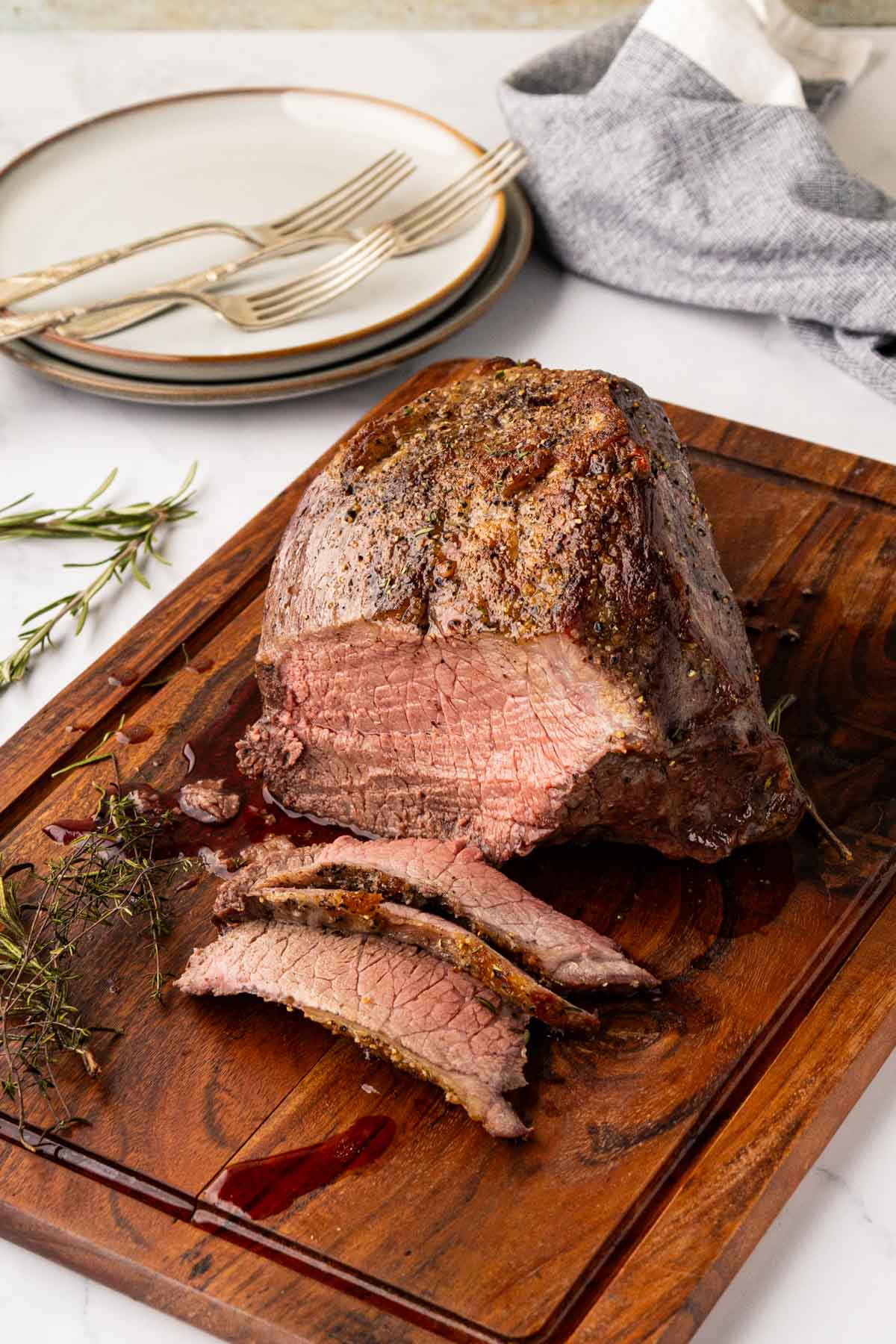
One thing I remember clearly from my childhood is rump roast showing up regularly on the Sunday-after-church menu. It was one of those comforting, dependable meals my mom made often — and it always meant we were sitting down together, slowing things down a bit.
It was also one of the first real meals I learned to cook from her. And once I had a little more experience under my belt, cooking for my own family, I started to make it my own.
One of the biggest changes I made after testing in my own kitchen was adding a high-heat sear before the slow roast. It’s a simple step, but it makes such a difference. That quick blast in the oven builds a flavorful crust and locks in all those natural juices.
This recipe is cozy, foolproof, and totally doable! The kind of meal that works just as well for a laid-back Sunday dinner as it does when you’re hosting. It delivers a perfectly tender, flavorful roast without the stress, which I know is exactly what many of us need in the middle of busy weeks and full schedules.
Whether you’re cooking for your family or serving a small crowd, this roast brings a little something extra to the table — comforting, memorable, and a touch elevated — without adding more to your plate.
Ingredient Notes
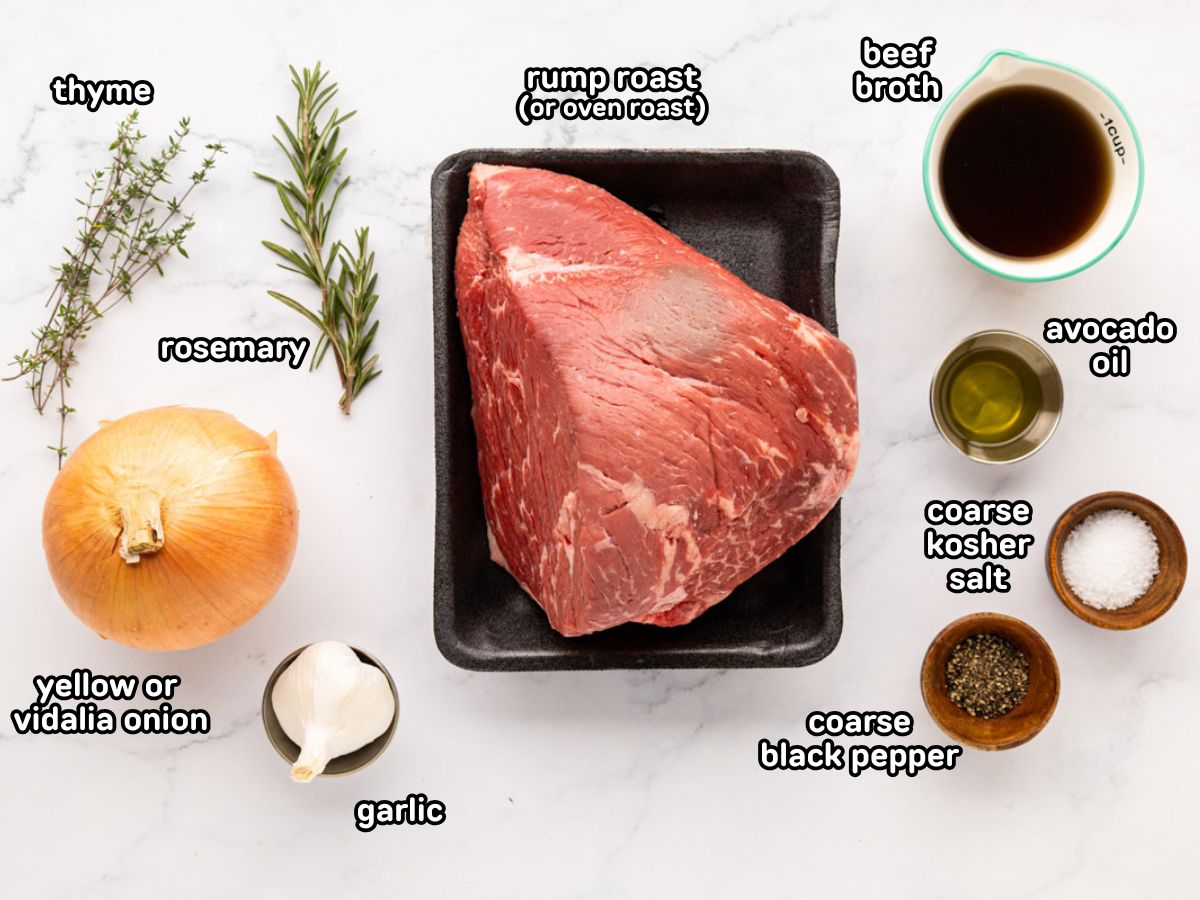
- Boneless Rump Roast: This lean cut comes from the hindquarter and is best cooked low and slow. It has a great beefy flavor and slices beautifully when cooked to rare or medium-rare. Look for a 3–4 pound roast with some marbling for added tenderness.
- Garlic Cloves: Whole garlic cloves roast right inside the meat and infuse it with a rich, mellow flavor in every bite. Feel free to adjust the amount based on your garlic love!
- Avocado Oil: I like avocado oil because it has a high smoke point, which makes it perfect for searing at 500°F. Olive oil can work too, but may smoke more at that high temp.
- Kosher Salt & Black Pepper: Simple but essential. Using coarse kosher salt and coarse ground black pepper helps create that flavorful crust we all love.
How to Cook Melt in Your Mouth Roast Beef
Step 1: Let the Roast Sit at Room Temperature
Take the roast out of the refrigerator and let it rest on the counter for 30 minutes before cooking. This helps the meat cook more evenly throughout. If it’s too cold, you’ll risk an overdone outside and an underdone center.
Step 2: Preheat the Oven and Prepare the Garlic
Preheat your oven to 500°F.
Using a sharp knife, cut 6-8 small slits evenly down into the top of the roast, but do not cut through the bottom. Gently press whole garlic cloves into each slit. The garlic will roast inside the meat, giving it a subtle, rich flavor in every slice.
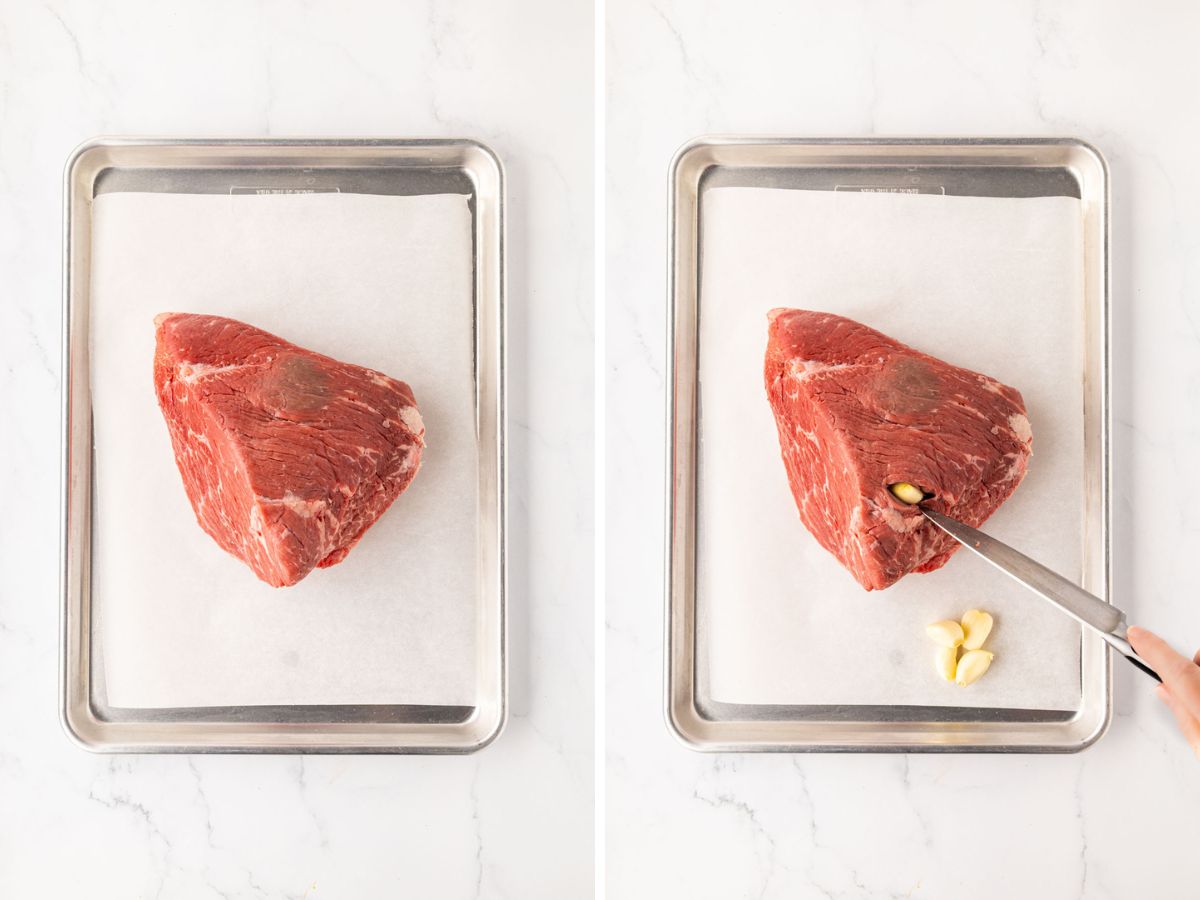
Step 3: Season the Roast
In a small bowl, mix together:
- Coarse kosher salt
- Coarse black pepper
Rub the entire roast with avocado oil, then coat it with the seasoning blend. Make sure to get all sides for maximum flavor.
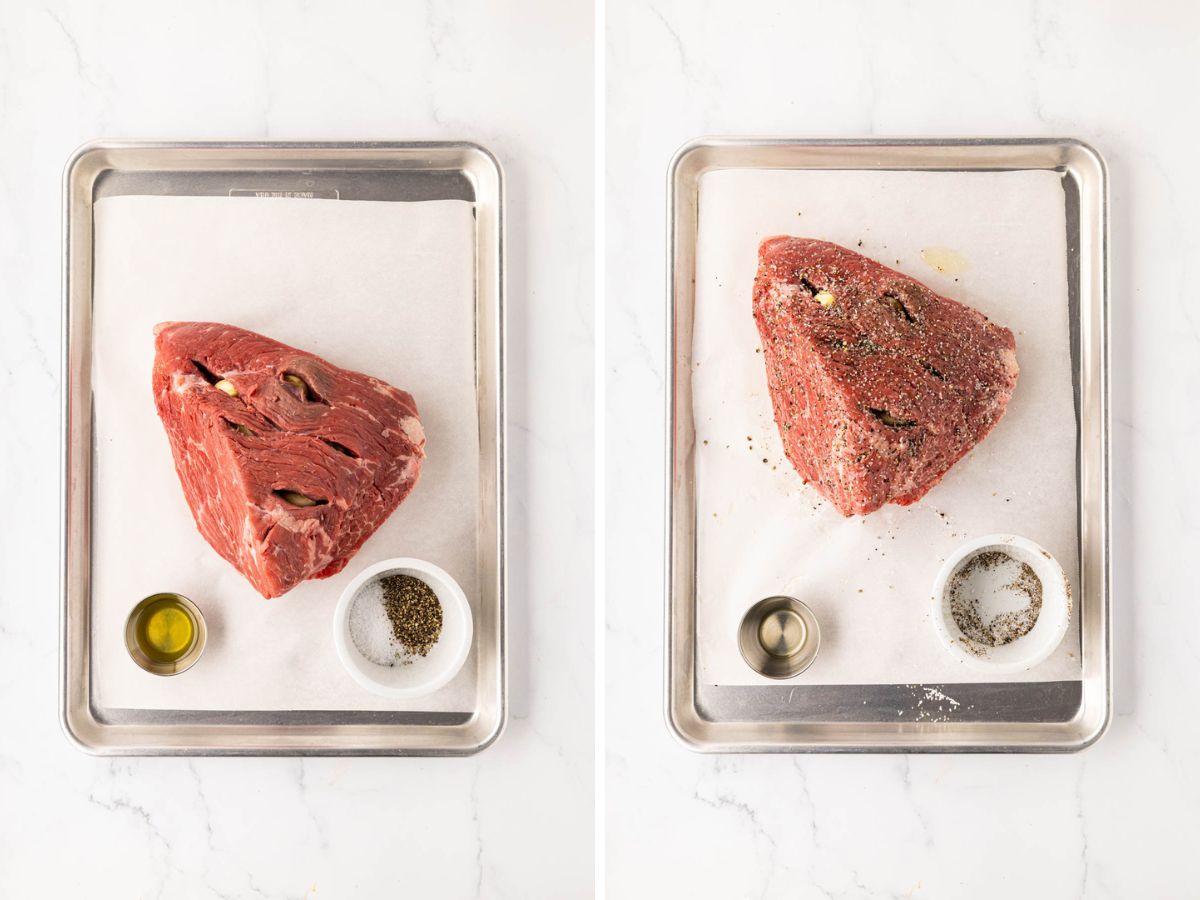
Step 4: Sear the Roast
Place the roast (UNCOVERED), fat side up, in a roasting pan or Dutch oven and roast at 500°F for 20 minutes. This high-heat step locks in juices and builds a beautiful crust on the outside.
Tip: If you have an oven-safe meat thermometer, this is the perfect time to insert it into the thickest part of the roast. Just be sure it’s not touching any fat or bone (if your cut has any). It lets you track the internal temperature as it cooks, so you can pull it out at the perfect moment.
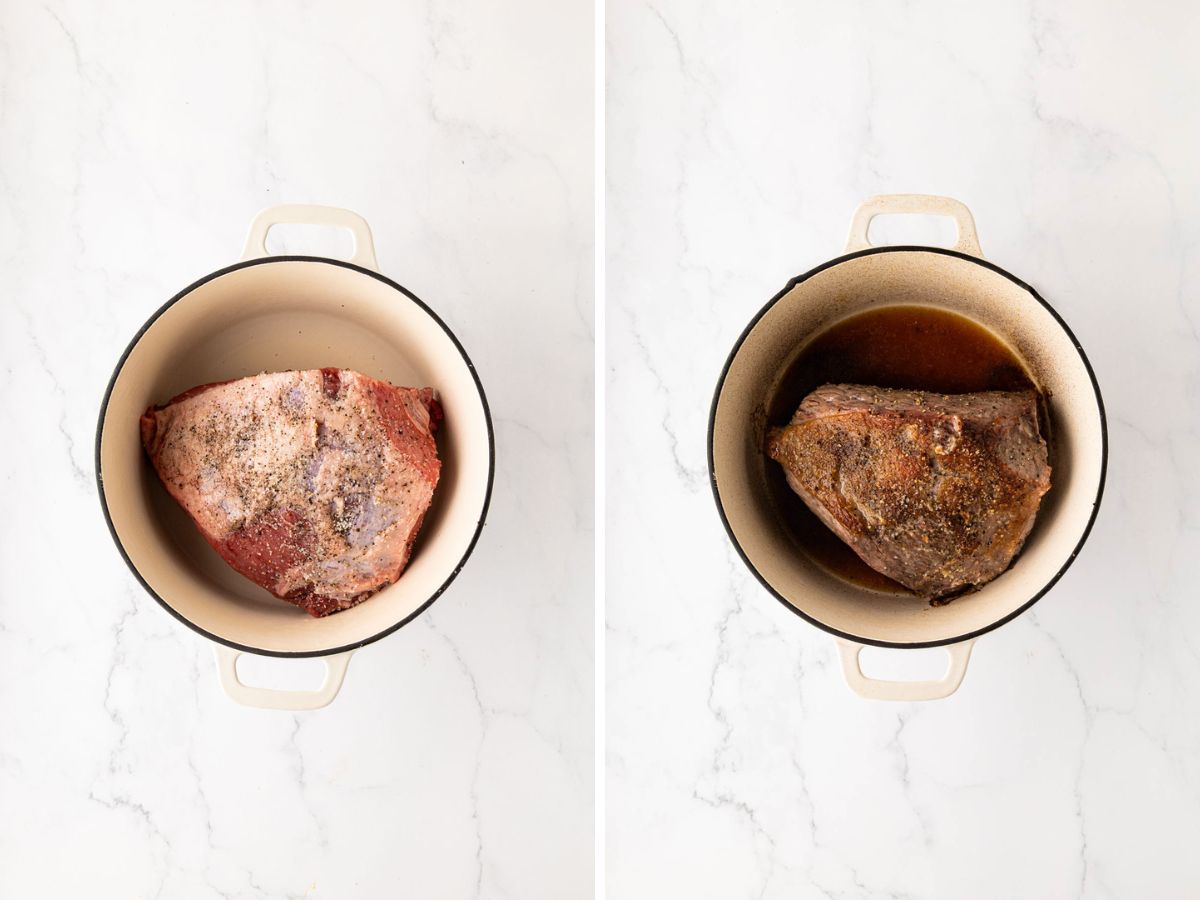
Step 5: Lower the Heat and Add Broth
After 20 minutes, remove the pan from the oven and reduce the oven temperature to 275°F.
Carefully pour 1 cup of beef broth into the bottom of the pan. If you’re using sliced Vidalia onion, scatter it around the roast for extra flavor and natural sweetness.
Then add fresh thyme leaves and minced rosemary (if using) .
Tip: Don’t feel like chopping herbs? No problem! You can lay a few whole sprigs of rosemary and thyme over the roast after the sear.
Return the roast to the oven, UNCOVERED, and roast at 275°F for approximately 20 minutes per pound, depending on your preferred doneness.
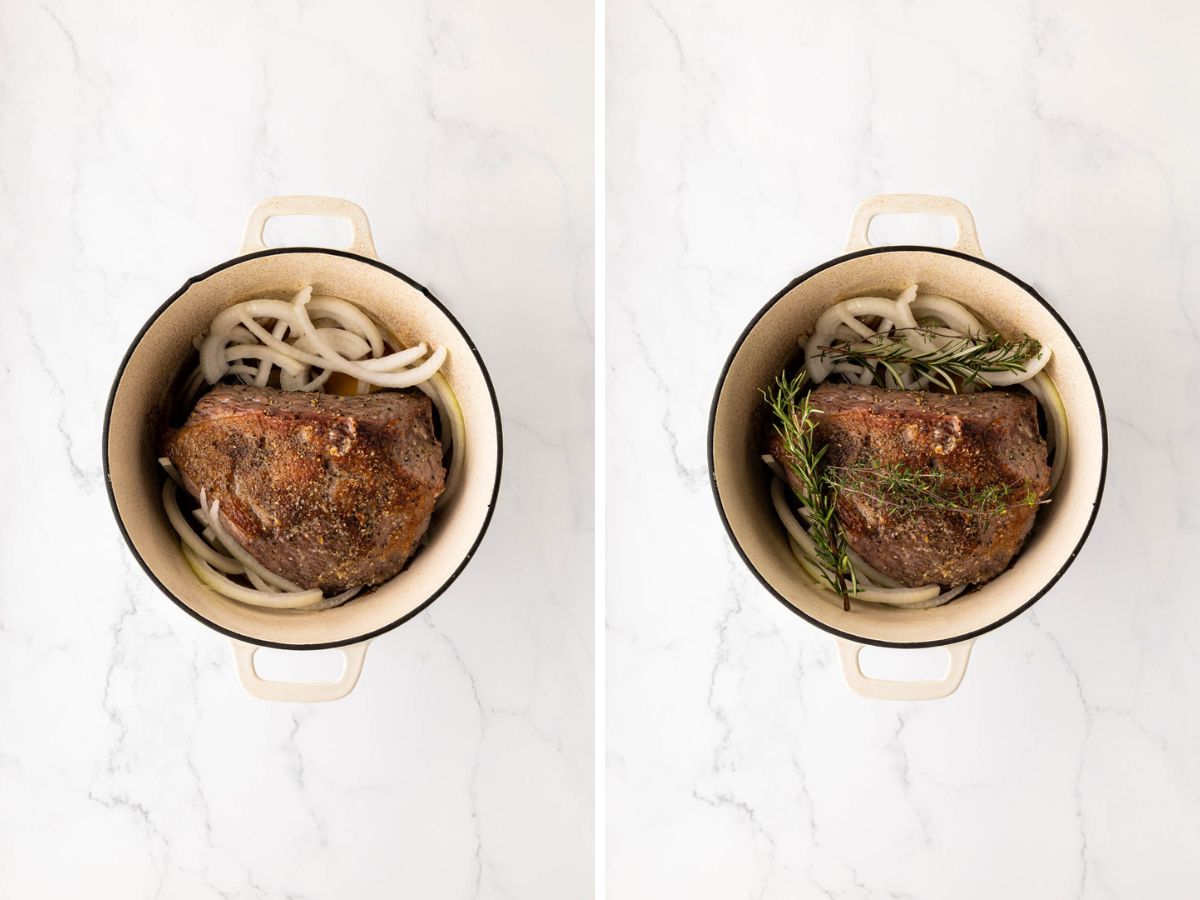
Step 6: Check the Temperature
If you used an oven-safe thermometer, keep an eye on it as the roast finishes cooking and remove the roast once it reaches your desired internal temperature (see the guide below).
If you’re using an instant-read thermometer, begin checking the temperature about 10 minutes before the estimated cook time is up. Insert it into the thickest part of the roast, avoiding any fat pockets.
Either way, remove the roast from the oven when it’s about 5°F below your target temp—the roast will continue to cook as it rests, a process called carryover cooking.
Step 7: Rest the Roast
Once your roast reaches the correct internal temperature, transfer it to a cutting board and tent it loosely with foil. Let it rest for at least 15 minutes. This allows the juices to redistribute, keeping the meat juicy and flavorful when sliced.
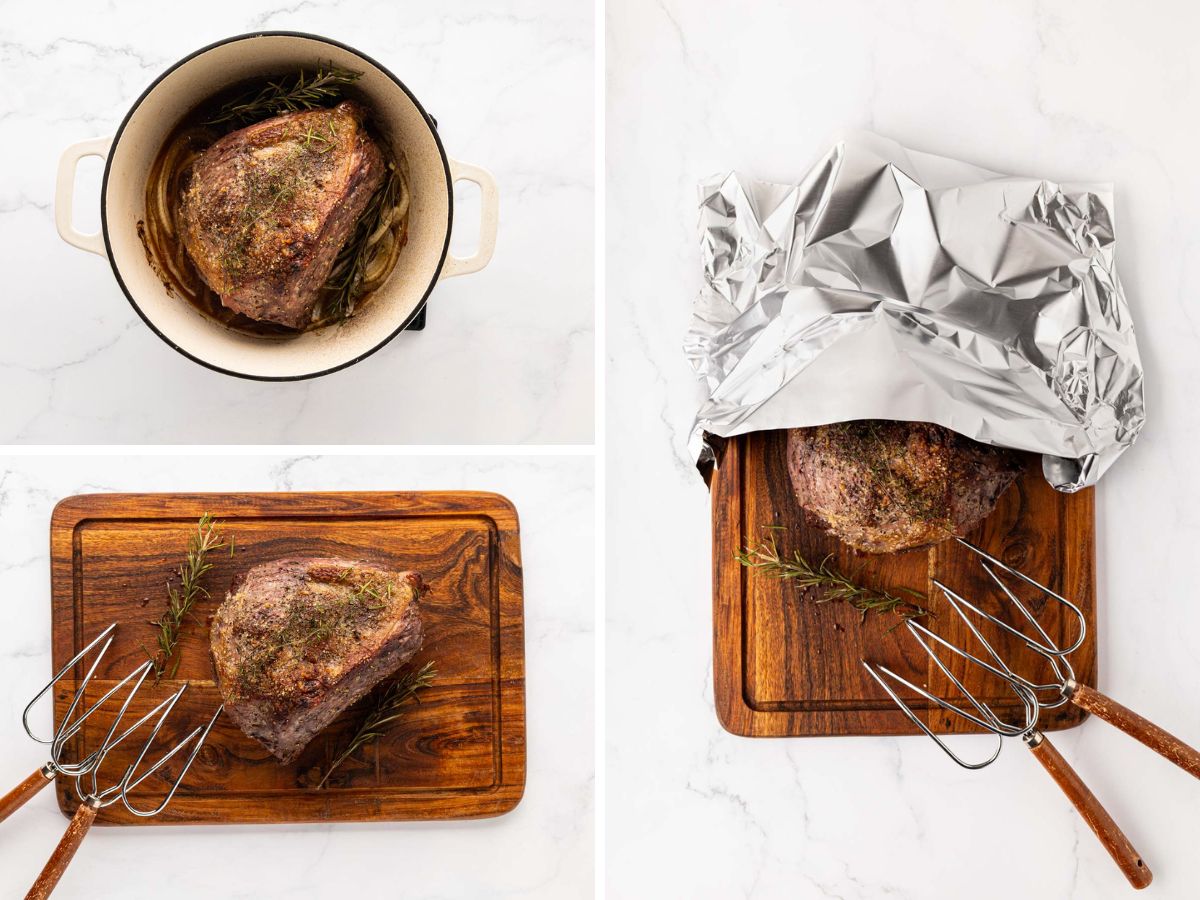
Optional: While the roast is resting, take a few minutes to whip up a batch of my Homemade Au Jus (recipe coming soon) using those delicious pan drippings. It’s an easy way to add even more rich flavor to your roast, and it’s especially great if you’re serving it with mashed potatoes or crusty bread!
Step 8: Slice and Serve
After resting, slice the roast thinly against the grain using a sharp carving knife. Slicing this way helps create tender, bite-sized pieces that practically melt in your mouth.
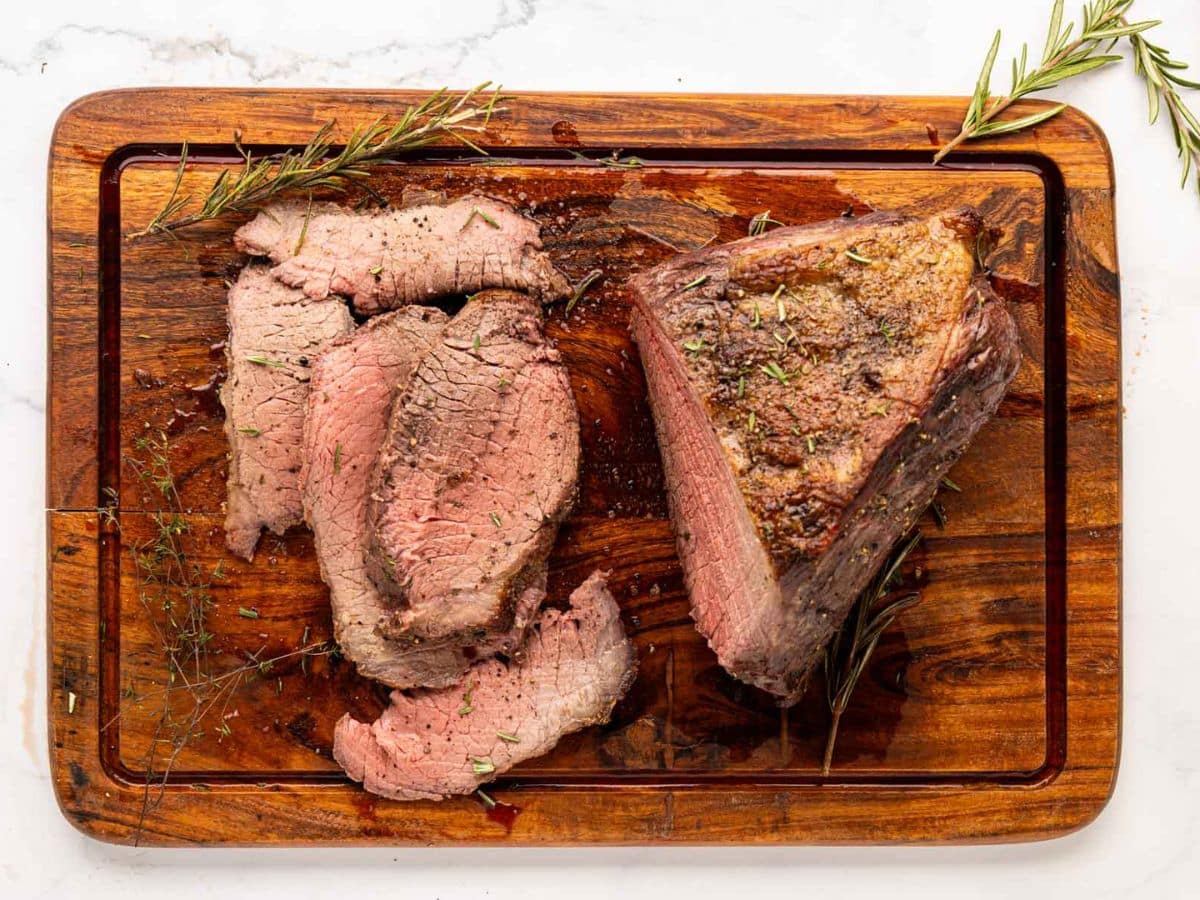
Serve warm, spooned with the pan juices or with homemade au jus.
Tip: If you’re not sure how to find the grain, look for the natural lines running through the meat and cut across them. This makes all the difference in tenderness!
Cooking Temperatures for Garlic Herb Roast
You’ll start with a 20-minute sear at 500°F, then lower the oven to 275°F and roast the beef uncovered until it reaches your desired internal temperature.
General Cook Time Guidelines
Roasting times vary depending on the roast’s size, shape, and temperature of the roast going into the oven. Use these guidelines after the initial sear:
- Rare to Medium-Rare: 20 to 25 minutes per pound
- Medium to Well-Done: 30 to 40 minutes per pound
| Roast Weight | Rare to Medium-Rare | Medium to Well-Done |
|---|---|---|
| 2 lbs | 40 to 50 minutes | 60 to 80 minutes |
| 2.5 lbs | 50 to 62 minutes | 75 to 100 minutes |
| 3 lbs | 60 to 75 minutes | 90 to 120 minutes |
| 3.5 lbs | 70 to 87 minutes | 105 to 140 minutes |
| 4 lbs | 80 to 100 minutes | 120 to 160 minutes |
Tip: Start checking the internal temperature with a meat thermometer 10–15 minutes before the estimated end time.
Internal Temperature Guide
- A meat thermometer will give the most accurate results, whether it’s an instant meat thermometer or an oven-safe thermometer.
- Remove the roast when it reaches 5°F below your target temperature to allow for carryover cooking while it rests.
| Doneness | Remove from Oven At | Final Temp After Resting |
|---|---|---|
| Rare | 120°F | 125°F |
| Medium-Rare | 130°F | 135°F |
| Medium | 140°F | 145°F |
| Medium-Well | 145°F | 150°F |
| Well-Done | 155°F | 160°F |
Nikki’s Kitchen Notes:
- Always let the roast rest 15–30 minutes, loosely tented with foil, before slicing. This allows juices to redistribute and keeps it tender.
- My 3-pound roast took 1 hour at 275°F after searing to reach rare doneness. I believe this is perfect for rump roast, which can get tough if overcooked.
Variations & Substitutions
- Garlic: If you don’t want to use whole cloves, you can mince the garlic and mix it right into the herb seasoning blend. Pre-minced garlic from the jar also works in a pinch, about 1 teaspoon per clove.
- Herbs: Fresh rosemary and thyme add a nice earthy flavor, but dried herbs work, too. Use 1 teaspoon of dried rosemary and ½ teaspoon of dried thyme in place of fresh.
- For a non-herbed roast, you can also skip the herbs altogether; salt, pepper, and garlic are delicious on their own.
- Onion: Vidalia onions add a natural sweetness to the pan, but yellow or white onions work just as well. If you’re not an onion fan, feel free to leave them out.
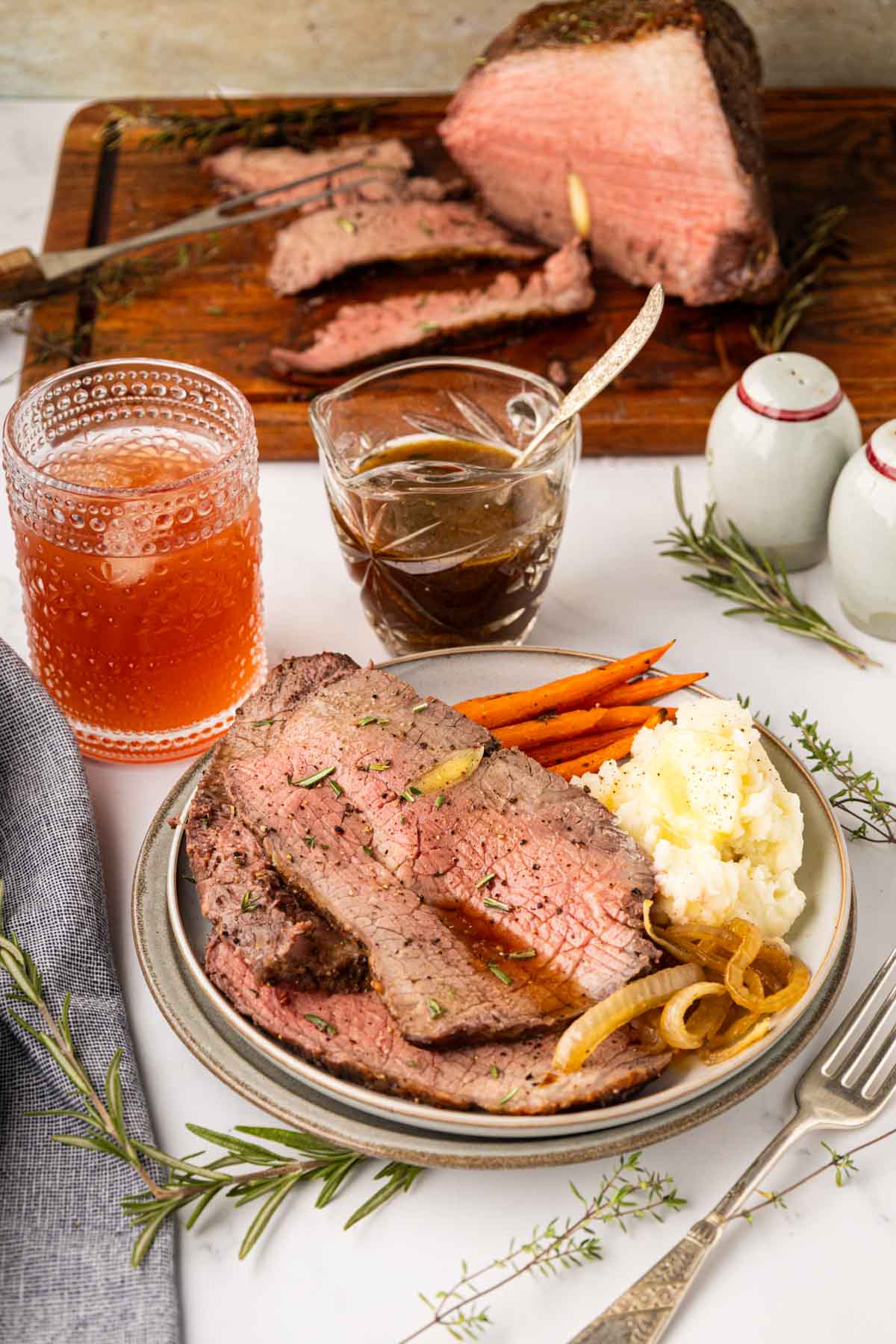
Want to Save this Recipe?
By submitting this form, you consent to receive emails from Soulfully Made.
What to Serve with Garlic Herb Rump Roast
Here are a few easy sides that pair well with this flavorful roast:
- Creamy Mashed Potatoes or buttered egg noodles
- Roasted carrots, southern-style green beans, or lima beans
- Dinner rolls or crusty bread for dipping in au jus
- Garden salad or cucumber & tomato salad for something fresh
- Rice pilaf or french onion rice for a cozy, comforting side
Add a glass of strawberry sweet tea and finish with your favorite dessert ( like this decadent chocolate mousse cake!) to round out the meal.
Hungry for more easy, home-cooked, delicious recipes?
Sign up for my free recipe club to get family-friendly recipes in your inbox each week! Find me sharing daily meal-time inspiration on Pinterest, Facebook, and Instagram.

Oven Roast Beef Recipe
Click Stars To Rate
Ingredients
- 3 – 4 pound rump roast - boneless
- 5-8 cloves garlic - whole , (or to taste)
- 1 tablespoon avocado oil
- 1 tablespoon coarse kosher salt
- 1 tablespoon coarse black pepper
- 1 tablespoon fresh thyme leaves - minced (optional)
- 1 tablespoon fresh rosemary - minced (optional)
- 1 cup beef broth
- 1 Vidalia onion - sliced (optional)
Instructions
- Bring to Room Temperature: Remove the roast from the refrigerator and let it sit out for 30 minutes to take the chill off. This helps it cook more evenly.
- Preheat the oven to 500°F.
- Cut 5–8 deep slits from the top, spacing them throughout the roast. Cut deep enough to reach into the center of the meat, but not all the way through. Insert a whole garlic clove into each slit, pressing it in so it stays tucked inside.
- Rub the roast all over with avocado oil, coating all sides evenly.
- Season: In a small bowl, combine salt, pepper, and herbs (if using). Press the seasoning mixture onto all sides of the roast so it coats the roast well.Optional: Instead of chopping the herbs, you can place whole sprigs of rosemary and thyme over the roast after the initial sear for a more subtle flavor.
- Sear: Place the roast uncovered in a roasting pan or Dutch oven and roast at 500°F for 20 minutes.
- Slow Roast: Remove the roast from the oven and reduce the temperature to 275°F. Pour the broth around the roast and scatter sliced onions around the roast (if using). Return the roast to the oven (uncovered) and cook for 20 minutes per pound, for rare to medium-rare doneness.
- Rest: Once the roast reaches your desired internal temperature (see chart below), remove it from the oven and transfer it to a cutting board.Loosely tent it with foil and let it rest for 15 to 30 minutes. This resting time allows the juices to redistribute, ensuring the roast remains moist and flavorful when sliced.Optional: While the roast rests, use the pan drippings to make my Homemade Au Jus, if desired.
- Slice: After the roast has rested, slice it thinly against the grain. This shortens the muscle fibers and gives you the most tender bite. Slicing with the grain will make the beef tough and chewy.
- Serve the roast warm, drizzled with the pan juices or au jus, and pair it with mashed potatoes, your favorite sides or salads.
Notes
| Doneness | Remove From Oven | Final Temp (After Resting) |
|---|---|---|
| Rare | 120°F | 125°F |
| Medium-Rare | 135°F | 140°F |
| Medium | 145°F | 150°F |
| Medium-Well | 155°F | 160°F |
| Well-Done | 160°F | 165°F |
Want to Save this Recipe?
By submitting this form, you consent to receive emails from Soulfully Made.
Nutrition
Tried this recipe?
Let us know how it was!This was originally posted on 11/4/2016 and updated on 10/29/2025 with new step-by-step images and more helpful tips.





We made this for dinner over the weekend, and it was so tender, juicy, and delicious. Definitely going in my recipe box to make again and again. The perfect oven roast recipe.
Thank you, Nicole! I love that you will be using this as your go-to oven roast recipe! You made my day!